- Home
- Eric Nylund
The Fall of Reach h-1 Page 11
The Fall of Reach h-1 Read online
Page 11
“Arm the MAC,” Captain Wallace told the weapons officer. “A heavy round.”
John understood: Turning your back to an enemy only gave them an advantage.
The MAC—Magnetic Accelerator Cannon—was the Commonwealth’s main weapon. It fired a super-dense ferric tungsten shell. The tremendous mass and velocity of the projectile obliterated most ships on impact. Unlike the Archer missiles, a MAC round was an unguided projectile; the firing solution had to be perfect in order to hit the target—not an easy thing to do when both ships were moving rapidly.
“MAC capacitors charging,” the weapons officer announced.
The Covenant ship turned its side toward the Commonwealth.
“Yes,” the Captain murmured. “Give me a bigger target.”
Pinpoints of blue light glowed and then flared along the alien hull.
The tactical view screens on the nose of the Commonwealth went dead.
John heard sizzling overhead—then the muffled thumps of explosive decompressions.
“More pulse laser hits,” the ops officer reported. “Armor in section three through seven down to four centimeters. Navigation dish destroyed. Hull breaches on decks two, five, and nine. We have a leak in the port fuel tanks.” The Lieutenant’s hand shakily danced over the controls. “Pumping fuel to starboard reverse tanks. Sealing sections.”
John shifted on his feet. He had to move. Act. Standing here—unable to get to his squad, not doing anything—was counter to every fiber of his being.
“MAC at one hundred percent,” the weapons officer shouted. “Ready to fire!”
“Fire!” Captain Wallace ordered.
The lights on the bridge dimmed and the Commonwealth shuddered. The MAC bolt launched through space—a red-hot metal slug moving at thirty thousand meters per second.
The Covenant ship’s engines flared to life and the ship veered away—
—Too late. The heavy round closed and slammed into the target’s prow.
The Covenant ship reeled backward through space. Its energy shields shimmered and glowed lightning-bright... then flickered, dimmed, and went out.
The bridge crew let out a victory cheer.
Except Dr. Halsey. John watched the view screen as she adjusted the camera controls and zoomed in on the Covenant ship.
The vessel’s erratic spinning slowed and it came to a stop. The ship’s nose was crumpled and atmosphere vented into vacuum. Tiny fires flickered inside. The ship slowly came about and started back toward them—gaining speed.
“It should have been destroyed,” she whispered.
Tiny red blobs appeared on the hull of the Covenant ship. They glowed and intensified and drifted together, collecting along the lateral line of the craft.
Captain Wallace said, “Make ready another heavy round.”
“Aye aye,” the weapons officer said. “Charge at thirty percent. Firing solution online, sir.”
“No,” Dr. Halsey said. “Evasive maneuvers, Captain. Now!”
“I won’t have my command second-guessed, ma’am.” The Captain turned to face her. “And with respect, Doctor, second-guessed by someone with no combat experience.” He stiffened and placed his hand behind his back. “I cannot have you removed from the bridge because the bulkheads are sealed... but another outburst like that, Doctor, and I will have you gagged.”
John shot a quick glance to Dr. Halsey. Her face flushed—he couldn’t tell from shame or rage.
“MAC at fifty percent charge.”
The red light continued to collect along the lateral line of the Covenant ship until it was a solid band. It brightened.
“Eighty percent charge.”
“They’re turning, sir,” the nav officer announced. “She’s coming to starboard.”
“Ninety-five percent charge—one hundred,” the weapons officer announced.
“Send them to Hades, Lieutenant. Fire.”
The lights dimmed again. The Commonwealth shuddered and a bolt of thunder and fire tore through the blackness.
The Covenant ship stood its ground. The bloodred light that had pooled on its lateral line burst forth—streaked toward the Commonwealth, passing the MAC round a mere kilometer away. The red light glowed and pulsed almost as if it were liquid; its edges roiled and fluttered. It elongated into a teardrop of ruby light five meters long.
“Evasive maneuvers,” Captain Wallace cried. “Emergency thrusters to port!”
The Commonwealth slowly moved out of the trajectory path of the Covenant’s energy weapon.
The MAC round struck the Covenant vessel amidships. Its shield shimmered and bubbled... then disappeared. The MAC round punched through the craft and sent it spinning out of control.
The inbound ball of light moved, too. It started tracking the Commonwealth.
“Engines—full power astern,” the Captain ordered. The Commonwealth rumbled and slowed.
The light should have sped past them; instead, it sharply arced and struck her port amidships.
The air filled with a popping and sizzling. The Commonwealth listed to starboard, then rolled completely over and continued to tumble.
“Stabilize,” the Captain cried. “Starboard thrusters.”
“Fire reported in sections one through twenty,” the ops officer said, panic creeping into his voice. “Decks two through seven in section one... have melted, sir. They’re gone.”
It grew noticeably hotter on the bridge. Sweat beaded on John’s back and trickled down his spine. He had never felt so helpless. Were his teammates below decks alive or dead?
“All port armor destroyed. Decks two through five in sections three, four, and five, are now out of contact, sir. It’s burning through us!”
Captain Wallace stood without saying a word. He stared at their one remaining view screen.
Dr. Halsey stepped forward. “Respectfully, Captain, I suggest that you alert the crew to get on respirator packs. Give them thirty seconds then vent the atmosphere on all decks, except the bridge.”
The COM officer looked to the Captain.
“Do it,” the Captain said. “Sound the alert.”
“Deck thirteen destroyed,” the ops officer announced. “Fire is getting close the reactor. Hull structure starting to buckle.”
“Vent atmosphere now,” Captain Wallance ordered.
“Aye aye,” the ops officer replied.
There was the sound of thumping through the hull... then nothing.
“Fire is dying out,” the ops officer said. “Hull temperature cooling—stabilizing.”
“What the hell did they hit us with?” Captain Wallace demanded.
“Plasma,” Dr. Halsey replied. “But not any plasma we know... they can actually guide its trajectory through space, without any detectable mechanism. Amazing.”
“Captain,” the navigator said. “Alien ship is pursuing.”
The Covenant vessel—a red-rimmed hole punched through its center—turned and started toward the Commonwealth.
“How... ?” Captain Wallace said unbelievingly. He quickly regained his wits. “Ready another MAC heavy round.”
The weapons officer slowly said, “MAC system destroyed, Captain.”
“We’re sitting ducks, then,” the Captain murmured.
Dr. Halsey leaned against the brass railing. “Not quite. The Commonwealth carries three nuclear missiles, correct, Captain?”
“A detonation this close would destroy us as well.”
She frowned and cupped her hand to her chin, thinking.
“Excuse me, sir,” John said. “The alien’s tactics thus far have been unnecessarily vicious—like those of an animal. They didn’t have to take that second MAC round while they fired at us. But they wanted to position themselves to fire. In my opinion sir, they would stop and engage anything that challenged them.”
The Captain looked to Dr. Halsey.
She shrugged and then nodded. “The Longsword interceptors?”
Captain Wallace turned his back to them and covere
d his face with his one hand. He sighed, nodded, and clicked on the intercom.
“Longsword Squadron Delta, this is the Captain. Get your ships into the black, boys, and engage the enemy ship. I need you to need to buy us some time.”
“Roger that, sir. We’re ready to launch. On our way.”
“Turn us around,” the Captain told the nav officer. “Give me best speed on a vector toward Chi Ceti Four orbit.”
“Coolant leaks in the reactor, sir,” the ops officer said. “We can push the engines to thirty percent. No more.”
“Give me fifty percent,” he said. He turned to the weapons officer. “Arm one of our Shiva warheads. Set proximity fuse to one hundred meters.”
“Yes, sir.”
The Commonwealth spun about. John felt the change in his stomach and he tightened his grip on the railing. The spinning slowed, stopped, then the ship accelerated.
“Reactor red-lining,” the ops officer reported. “Meltdown in twenty-five seconds.”
Over the speakers, there was a crackle, a hiss of static, then: “Longsword interceptors engaging the enemy, sir.”
On the remaining aft camera, there were flickers of light—the cold blue strobes of Covenant energy weapons, and the red-orange fireballs of the Longswords’ missiles.
“Launch the missile,” the Captain said.
“Meltdown in ten seconds.”
“Missile away.”
A plume of exhaust divided the darkness of space.
“Five seconds to meltdown,” the ops officer said. “Four, three, two—”
“Shunt drive plasma to space,” the Captain ordered. “Cut power to all systems.”
The Covenant ship was silhouetted for a split second by pure white—then the view screen snapped off. The bridge lights went dead.
John could see everything, though. The bridge officers, Dr. Halsey as she clutched onto the railing, and Captain Wallace as he stood and saluted the pilots he had just sent to die.
The hull of the Commonwealth rumbled and pinged as the shock wave enveloped them. It grew louder, a subsonic roar that shook John to his bones.
The noise seemed to go on forever in the darkness. It faded... then it was completely silent.
“Power us back up,” the Captain said. “Slowly. Give me ten percent from the reactors if we can manage.”
The bridge lights came on, dimly, but they worked.
“Report,” the Captain ordered.
“All sensors offline,” the op officer said. “Resetting backup computer. Hang on. Scanning now. Lots of debris. It’s hot back there. All Longsword interceptors vaporized.” He looked up, the color drained from his face. “Covenant ship... intact, sir.”
“No,” the Captain said, and made a fist.
“It’s moving off, though,” the op officer said with a visible sigh of relief. “Very slowly.”
“What does it take to destroy one of those things?” the Captain whispered.
“We don’t know if our weapons can destroy them,” Dr. Halsey said. “But at least we know we can slow them down.”
The Captain stood straighter. “Best speed to the Damascus testing facility. We will execute a flyby orbit, and then proceed to a point twenty million kilometers distant to make repairs.”
“Captain?” Dr. Halsey said. “A flyby?”
“I have orders to get you to the facility and retrieve whatever Section Three has stowed there, ma’am. As we fly by, a dropship will take you and your—” He glanced at John. “—crew planet side. If the Covenant ship returns, we will be the bait to lure them away.”
“I understand, Captain.”
“We’ll rendezvous in orbit no later than 1900 hours.”
Dr. Halsey turned to John. “We need to hurry. We don’t have much time—and there is a great deal I need to show the Spartans.”
“Yes, ma’am,” John said. He took a long look at the bridge, and hoped he never had to return.
CHAPTER THIRTEEN
1845 Hours, November 27, 2525 (Military Calendar)
UNSC Damascus Materials Testing Facility, planet Chi Ceti 4
How far down was the testing facility? John and the other Spartans had been confined to a freight elevator for fifteen minutes, and the entire time it had been rapidly descending into the depths of Chi Ceti 4.
The last place John wanted to be was in another confined space.
The doors finally slid open, and they emerged in what appeared to be a well-lit hangar. The far end had an obstacle course set up with walls, trenches, dummy targets, and barbed wire.
Three technicians and at least a dozen AI figures were busy in the center of the room. John had seen AIs before—one at a time. Déjà had once told the Spartans that there were technical reasons why AIs couldn’t be in the same place at the same time, but here were many ghostly figures: a mermaid, a samurai warrior, and one made entirely of bright light with comets trailing in her wake.
Dr. Halsey cleared her throat. The technicians turned—the AIs vanished.
John had been so focused on the holograms that he hadn’t noticed the forty Plexiglas mannequins set up in rows. On each was a suit of armor.
The armor reminded John of the exoskeletons he had seen during training, but much less bulky, more compact. He stepped closer to one and saw that the suit actually had many layers; the outer layer reflected the overhead lights with a faint green-gold iridescence. It covered the groin, outer thighs, knees, shins, chest, shoulders, and forearms. There was a helmet and an integrated power pack—much smaller than standard Marine “battery sacks.” Underneath were intermeshed layers of matte-black metal.
“Project MJOLNIR,” Dr. Halsey said. She snapped her fingers and an exploded holographic schematic of the armor appeared next to her.
“The armor’s shell is a multilayer alloy of remarkable strength. We recently added a refractive coating to disperse incoming energy weapon attacks—to counter our new enemies.” She pointed inside the schematic. “Each battlesuit also has a gel-filled layer to regulate temperature; this layer can reactively change in density. Against the skin of the operator, there is a moisture-absorbing cloth suit, and biomonitors that constantly adjust the suit’s temperature and fit. There’s also an onboard computer that interfaces with your standard-issue neural implant.”
She gestured and the schematic collapsed so that it only displayed the outer layers. As the image changed, John glimpsed veinlike microcapillaries, a dense sandwich of optical crystal, a circulating pump, even what looked like a miniature fusion cell in the backpack.
“Most importantly,” Dr. Halsey said, “the armor’s inner structure is composed of a new reactive metal liquid crystal. It is amorphous, yet fractally scales and amplifies force. In simplified terms, the armor doubles the wearer’s strength, and enhances the reaction speed of a normal human by a factor of five.”
She waved her hand through the hologram. “There is one problem, however. This system is so reactive that our previous tests with unaugmented volunteers ended in—” She searched for right word. “—failure.” She nodded to one of the technicians.
A flat video appeared in the air. It showed a Marine officer, a Lieutenant, being fitted with the MJOLNIR armor. “Power is on,” someone said from offscreen. “Move your right arm, please.”
The soldier’s arm blurred forward with incredible speed. The Marine’s stoic expression collapsed into shock, surprise, and pain as his arm shattered. He convulsed—shuddered and screamed. As he jerked in pain John could hear the sounds of bones breaking.
The man’s own agony-induced spasms were killing him.
Halsey waved the video away. “Normal humans don’t have the reaction time or strength required to drive this system,” she explained. “You do. Your enhanced musculature and the metal and ceramic layers that have been bonded to your skeleton should be enough to allow you to harness the armor’s power. There has been... insufficient computer modeling, however. There will be some risk. You’ll have to move very slowly and delibera
tely until you get a feel for the armor and how it works. It cannot be powered down, nor can the response be scaled back. Do you understand?”
“Yes, Ma’am,” the Spartans answered.
“Questions?”
John raised his hand. “When do we get to try them, Doctor?”
“Right now,” she said. “Volunteers?”
Every Spartan raised a hand.
Dr. Halsey allowed herself a tiny smile. She surveyed them, and finally, she turned to John.
“You’ve always been lucky, John,” she said. “Let’s go.”
He stepped forward. The technicians fitted him as the others watched and the pieces of the MJOLNIR system were assembled around his body. It was like a giant three-dimensional puzzle.
“Please breathe normally,” Dr. Halsey told him, “but otherwise remain absolutely still.”
John held himself as motionless as he could. The armor shifted and melded to the contours of his form. It was like a second skin... and much lighter than he had thought it would be. It heated, then cooled—then matched the temperature of his body. If he closed his eyes, he wouldn’t have known he was encased.
They set the helmet over his head.
Health monitors, motion sensors, suit status indicators pulsed into life. A targeting reticle flickered on the heads-up display.
“Everyone move back,” Halsey ordered.
The Spartans—from their expressions, they were concerned for him, but still intensely curious—cleared a ring with a radius of three meters around him.
“Listen carefully to me, John,” Dr. Halsey said. “I just want you to think, and only think, about moving your arm up to chest level. Stay relaxed.”
He willed his arm to move, and his hand and forearm sprang forward to chest level. The slightest motion translated his thought to motion at lightning speed. It had been so fast—if he hadn’t been attached to his arm, he might have missed that it had happened at all.
The Spartans gasped.
Sam applauded. Even lightning-fast Kelly seemed impressed.
Dr. Halsey slowly coached John through the basics of walking and gradually built up the speed and complexity of his motions. After fifteen minutes he could walk, run, and jump almost without thinking of the difference between suit motion and normal motion.

 A Thousand Drunken Monkeys: Book 2 in the Hero of Thera series
A Thousand Drunken Monkeys: Book 2 in the Hero of Thera series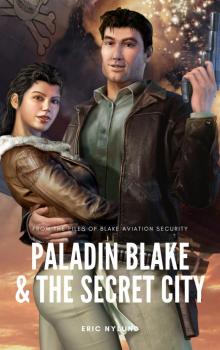 Paladin Blake & The Secret City
Paladin Blake & The Secret City A Thousand Drunken Monkeys
A Thousand Drunken Monkeys Halo: Evolutions - Essential Tales of the Halo Universe
Halo: Evolutions - Essential Tales of the Halo Universe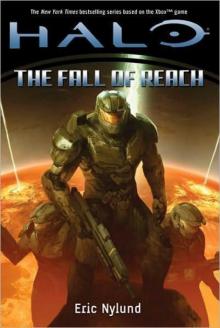 Halo: The Fall of Reach
Halo: The Fall of Reach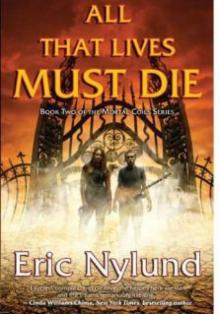 All That Lives Must Die mc-2
All That Lives Must Die mc-2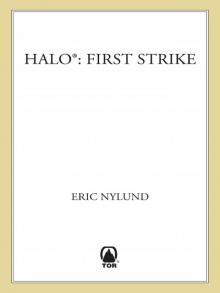 First Strike
First Strike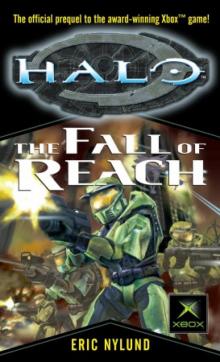 The Fall of Reach h-1
The Fall of Reach h-1